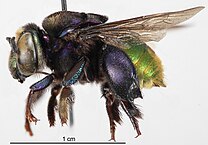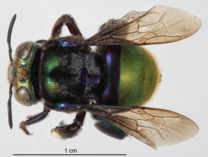Eufriesea purpurata is a species of eusocial orchid bee common in northeastern South America, particularly in the Amazon basin.[1][2] It is an important pollinator of various wild plants, and it is noted for its attraction to various synthetic compounds used by humans, including some insecticides. In the late 1970s, males of the species pestered an indigenous Amazonian community whose palm-leaf houses had been sprayed by the government with DDT, which the bees found attractive.
| Eufriesea purpurata | |
|---|---|
| Lateral and dorsal views of E. purpurata | |
| Scientific classification | |
| Domain: | Eukaryota |
| Kingdom: | Animalia |
| Phylum: | Arthropoda |
| Class: | Insecta |
| Order: | Hymenoptera |
| Family: | Apidae |
| Genus: | Eufriesea |
| Species: | E. purpurata
|
| Binomial name | |
| Eufriesea purpurata Mocsáry, 1896
| |
| Synonyms | |
| |
Morphology
editEufriesea purpurata has a bright green metallic-colored head with red-orange highlights, a short tongue (5–6 mm), an adult body length of 14–17 mm, and an average body weight of 50 mg.[3][4] Its thorax is most often purple, but can also be reddish, yellow, or green.[1]
Natural ecology
editLike other euglossine bees, E. purpurata males collect volatile floral scents, possibly for courtship purposes.[5] Adolf Ducke described Eufriesea purpurata collecting Melastomataceae bark and resin as nest-building materials.[6] Eufriesea purpurata is considered a pest to Anthurium cultivation because of its indiscriminate cross-pollination of flowers.[1] It is the sole pollinator of the Stanhopea insignis species of orchid, which attracts the bees with its fragrance.[7] It is also a pollinator of the orchids Cycnoches aureum, Dressleria helleri, and Gongora spp., as well as the monocots Spathiphyllum cannaefolium and Coryanthes spp. and the eudicot Mouriri nervosa.[8][9][10] It has been observed rarely visiting the flowers of the Brazil nut tree, but is considered unlikely to be an important pollinator of the plant.[11]
Attraction to insecticides
editThe bee is attracted to and unharmed by the insecticide DDT. In 1979 and 1980, males of the species were observed deliberately collecting large quantities of the insecticide from remote, rural houses along Brazil's Ituxi River. The houses, which were constructed from palm leaves, had been treated with DDT in the summer of 1979 by the government to prevent the spread of malaria.[4] Attracted by the smell of the insecticide, the bees were observed finding and returning often to the DDT-sprayed houses, entering the homes to scrape dried insecticide from the walls into their hind tibial pouches. Individual bees of the species were observed collecting as much as 2 mg of DDT each (4% of their average body weight)[12] with no apparent adverse effects, displaying a tolerance tens or hundreds of times greater than most insects. The bees do not ingest or otherwise metabolize the collected DDT,[13][14] which Whitten suggests "must mimic some natural product sought by the bee".[15] Interviews with locals revealed that there had been no house-visiting bees until the malaria control spray program had begun. Of families interviewed, 95% reported some disturbance from the bees' noise, and 71% of interviewees had bees in their homes during their interviews.[13]
Eufriesea purpurata has also been observed collecting the insecticide aldrin. One scientific account from Peru describes hundreds of male bees drawn to aldrin-treated wood walls, which were "actually scarred by [the bees'] repeated scratching".[16][17] E. purpurata has also been found to be attracted to benzyl alcohol, a major component of Stanhopea insignis' fragrance, and anisyl acetate.[7][18][19]
See also
edit- Helaeomyia petrolei, a fly that develops in crude oil
References
edit- ^ a b c Kimsey, Lynn Siri (1 January 1982). Systematics of Bees of the Genus Eufriesea (Hymenoptera, Apidae). University of California Press. p. 75. ISBN 978-0-520-09643-1.
- ^ Annotationes Zoologicae Japonenses. Societas. 1965. p. 219.
- ^ Kimsey, Lynn Siri (1 January 1982). Systematics of Bees of the Genus Eufriesea (Hymenoptera, Apidae). University of California Press. p. 20. ISBN 978-0-520-09643-1.
- ^ a b Vetter, Walter; Roberts, Donald (15 May 2007). "Revisiting the organohalogens associated with 1979-samples of Brazilian bees (Eufriesea purpurata)". Science of the Total Environment. 377 (2): 371–377. Bibcode:2007ScTEn.377..371V. doi:10.1016/j.scitotenv.2007.02.009. PMID 17379276.
- ^ Eltz, Thomas; Sager, Andreas; Lunau, Klaus (2005). "Juggling with volatiles: Exposure of perfumes by displaying male orchid bees". Journal of Comparative Physiology A. 191 (7): 575–581. doi:10.1007/s00359-005-0603-2. S2CID 15934584.
- ^ Ducke, Adolf (1905). "Biologische Notizen über einige südamerikanische Hymenoptera" [Biological Notes on Some South American Hymenoptera]. Zeitschrift für wissenschaftliche Insektenbiologie (in German). 1: 175–177.
- ^ a b Pansarin, Emerson Ricardo; Amaral, Maria do Carmo Estanislau do (January 2009). "Reproductive biology and pollination of southeastern Brazilian Stanhopea Frost ex Hook. (Orchidaceae)". Flora – Morphology, Distribution, Functional Ecology of Plants. 204 (3): 238–249. doi:10.1016/j.flora.2008.01.014.
- ^ Hanson, P. E.; Gauld, I. D., eds. (1995). The Hymenoptera of Costa Rica. Oxford University Press. ISBN 0-19-854905-9.
- ^ Williams, Norris H.; Dressler, Robert L. (1976). "Euglossine pollination of Spathiphyllum (Araceae)". Selbyana. 1 (4): 349–356. JSTOR 41759603.
- ^ Missouri Botanical Garden.; Garden, Missouri Botanical; Botany, Henry Shaw School of (1989). Annals of the Missouri Botanical Garden. Vol. v.76 (1989). St. Louis: Missouri Botanical Garden Press. p. 507.
- ^ Cavalcante, M. C.; Oliveira, F. F.; Maués, M. M.; Freitas, B. M. (28 May 2012). "Pollination Requirements and the Foraging Behavior of Potential Pollinators of Cultivated Brazil Nut (Bertholletia excelsa Bonpl.) Trees in Central Amazon Rainforest". Psyche: A Journal of Entomology. 2012: e978019. doi:10.1155/2012/978019.
- ^ May, Paul; Cotton, Simon (23 October 2014). Molecules That Amaze Us. CRC Press. p. 141. ISBN 978-1-4665-8961-2.
- ^ a b Roberts, Donald R.; Alecrim, Wilson D.; Heller, Jack M.; Ehrhardt, Susan R.; Lima, Jose B. (6 May 1982). "Male Eufriesia purpurata, a DDT-collecting euglossine bee in Brazil". Nature. 297 (5861): 62–63. Bibcode:1982Natur.297...62R. doi:10.1038/297062a0. S2CID 4257709.
- ^ Williams, Norris H.; Whitten, W. Mark (June 1983). "Orchid Floral Fragrances and Male Euglossine Bees: Methods and Advances in the Last Sesquidecade". The Biological Bulletin. 164 (3): 355–395. doi:10.2307/1541248. JSTOR 1541248.
- ^ Whitten, William Mark; Whitten, William Mark (1985). Variation in floral fragrances and pollinators in the Gongora quinquenervis complex (Orchidaceae) in central Panama. p. 116. doi:10.5962/bhl.title.42485.
- ^ Dressler, Robert (1967). "Why Do Euglossine Bees Visit Orchid Flowers?". Atas do Simpósio sôbre a Biota Amazônica. 5: 171–180.
- ^ Cameron, Sydney A. (January 2004). "Phylogeny and biology of Neotropical orchid bees (Euglossini)". Annual Review of Entomology. 49 (1): 377–404. doi:10.1146/annurev.ento.49.072103.115855. PMID 14651469.
- ^ Pearson, David L.; Dressler, Robert L (February 1985). "Two-year study of male orchid bee (Hymenoptera: Apidae: Euglossini) attraction to chemical baits in lowland south-eastern Perú". Journal of Tropical Ecology. 1 (1). Cambridge University Press: 37–54. doi:10.1017/S0266467400000067. S2CID 84040115.
- ^ Londoño Carvajal, C. (2022). Abejas del género Eufriesea Cockerell, 1908 (Apidae: Euglossini): Actualización sobre presencia y distribución en Colombia [Bees of the genus Eufriesea Cockerell, 1908 (Apidae: Euglossini): Update on presence and distribution in Colombia] (M.S., Entomology thesis) (in Spanish). National University of Colombia.

